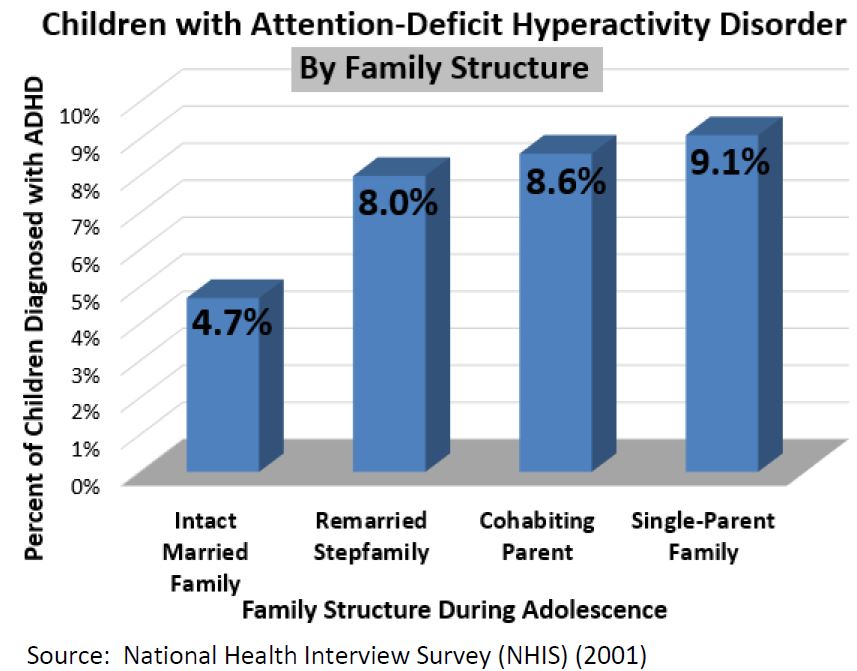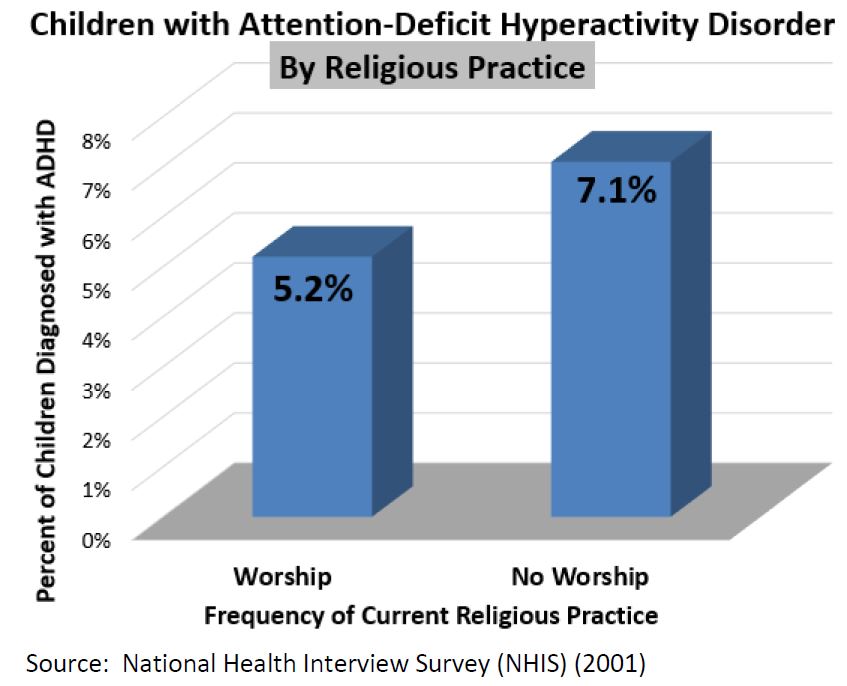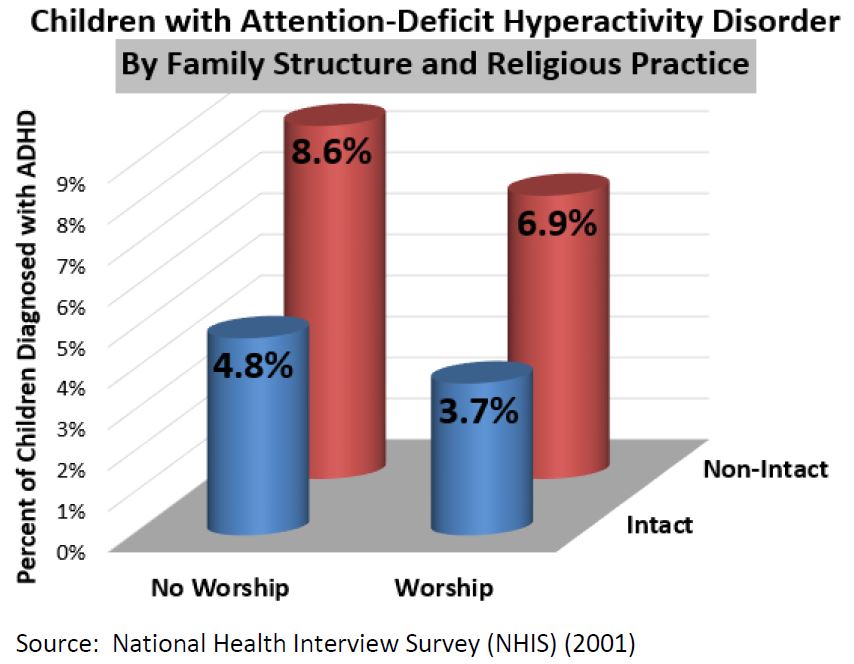Click Here to download “Children with Attention-Deficit Hyperactivity Disorder (ADHD) by Family Structure and Religious Practice”
Children with Attention-Deficit Hyperactivity Disorder (ADHD) by Family Structure and Religious Practice
The 2001 cycle of the National Health Interview Survey (NHIS) showed that children in intact families that worshipped
[1] were least likely to have been diagnosed with Attention-Deficit Hyperactivity Disorder (ADHD).
[2]
Family Structure: According to the 2001 cycle of the National Health Interview Survey, 4.7% of children in intact married families, 8.0% of children raised in remarried stepfamilies, and 8.6% of children living with a cohabiting parent had been told by a doctor that they had ADHD. Children living in single-parent families were most likely to have been diagnosed with ADHD (9.1%).
 Religious Practice:
Religious Practice: The 2001 cycle of the National Health Interview Survey showed that fewer children from families who worshipped had been diagnosed with ADHD (5.2%) than children whose families did not worship (7.1%).
 Family Structure and Religious Practice Combined:
Family Structure and Religious Practice Combined: Children in intact families that worshipped were least likely to have been diagnosed with ADHD (3.7%), followed by children in intact non-worshipping families (4.8%) and non-intact worshipping families (6.9%). Children in non-intact non-worshipping families were most likely to have been told by a doctor that they have ADHD (8.6%)—more than double that of children in intact worshipping families.
 Related Insights from Other Studies:
Related Insights from Other Studies: A robust collection of research shows that family structure can significantly impact the mental health of children. Ann-Margret Rydell found that single parenthood and step-parenthood was associated with high levels of ADHD symptoms, and that family conflict had a strong additive effect on the level of ADHD symptoms in children (beyond the effects of demographic factors).
[3] Using the National Survey of Children’s Health, Matthew D. Bramlett and Stephen J. Blumberg found that more than two times as many children raised in blended step-families, blended adoptive families, and grandparent families were ever told their child has ADD/ ADHD than children raised in two-parent families.
[4] These studies reiterate that children tend to be healthier in two-parent biological families.
[1] A worshipping family has attended at least one worship service in the past two weeks.
[2] These charts draw on data collected by the National Health Interview Survey, 2001
[3] Rydell, Ann-Margret. “Family factors and children’s disruptive behavior: an investigation of links between demographic characteristics, negative life events and symptoms of ODD and ADHD.”
Sociological Psychiatric Epidemiology 45 (2010): 233-244.
[4] Bramlett, Matthew D. and Blumberg, Stephen J. “Family structure and children’s physical and mental health.”
Health Affairs 26 (2007): 549-558.
]]>
 Religious Practice: The 2001 cycle of the National Health Interview Survey showed that fewer children from families who worshipped had been diagnosed with ADHD (5.2%) than children whose families did not worship (7.1%).
Religious Practice: The 2001 cycle of the National Health Interview Survey showed that fewer children from families who worshipped had been diagnosed with ADHD (5.2%) than children whose families did not worship (7.1%).
 Family Structure and Religious Practice Combined: Children in intact families that worshipped were least likely to have been diagnosed with ADHD (3.7%), followed by children in intact non-worshipping families (4.8%) and non-intact worshipping families (6.9%). Children in non-intact non-worshipping families were most likely to have been told by a doctor that they have ADHD (8.6%)—more than double that of children in intact worshipping families.
Family Structure and Religious Practice Combined: Children in intact families that worshipped were least likely to have been diagnosed with ADHD (3.7%), followed by children in intact non-worshipping families (4.8%) and non-intact worshipping families (6.9%). Children in non-intact non-worshipping families were most likely to have been told by a doctor that they have ADHD (8.6%)—more than double that of children in intact worshipping families.
 Related Insights from Other Studies: A robust collection of research shows that family structure can significantly impact the mental health of children. Ann-Margret Rydell found that single parenthood and step-parenthood was associated with high levels of ADHD symptoms, and that family conflict had a strong additive effect on the level of ADHD symptoms in children (beyond the effects of demographic factors). [3] Using the National Survey of Children’s Health, Matthew D. Bramlett and Stephen J. Blumberg found that more than two times as many children raised in blended step-families, blended adoptive families, and grandparent families were ever told their child has ADD/ ADHD than children raised in two-parent families.[4] These studies reiterate that children tend to be healthier in two-parent biological families.
[1] A worshipping family has attended at least one worship service in the past two weeks.
[2] These charts draw on data collected by the National Health Interview Survey, 2001
[3] Rydell, Ann-Margret. “Family factors and children’s disruptive behavior: an investigation of links between demographic characteristics, negative life events and symptoms of ODD and ADHD.” Sociological Psychiatric Epidemiology 45 (2010): 233-244.
[4] Bramlett, Matthew D. and Blumberg, Stephen J. “Family structure and children’s physical and mental health.” Health Affairs 26 (2007): 549-558.
]]>
Related Insights from Other Studies: A robust collection of research shows that family structure can significantly impact the mental health of children. Ann-Margret Rydell found that single parenthood and step-parenthood was associated with high levels of ADHD symptoms, and that family conflict had a strong additive effect on the level of ADHD symptoms in children (beyond the effects of demographic factors). [3] Using the National Survey of Children’s Health, Matthew D. Bramlett and Stephen J. Blumberg found that more than two times as many children raised in blended step-families, blended adoptive families, and grandparent families were ever told their child has ADD/ ADHD than children raised in two-parent families.[4] These studies reiterate that children tend to be healthier in two-parent biological families.
[1] A worshipping family has attended at least one worship service in the past two weeks.
[2] These charts draw on data collected by the National Health Interview Survey, 2001
[3] Rydell, Ann-Margret. “Family factors and children’s disruptive behavior: an investigation of links between demographic characteristics, negative life events and symptoms of ODD and ADHD.” Sociological Psychiatric Epidemiology 45 (2010): 233-244.
[4] Bramlett, Matthew D. and Blumberg, Stephen J. “Family structure and children’s physical and mental health.” Health Affairs 26 (2007): 549-558.
]]>
